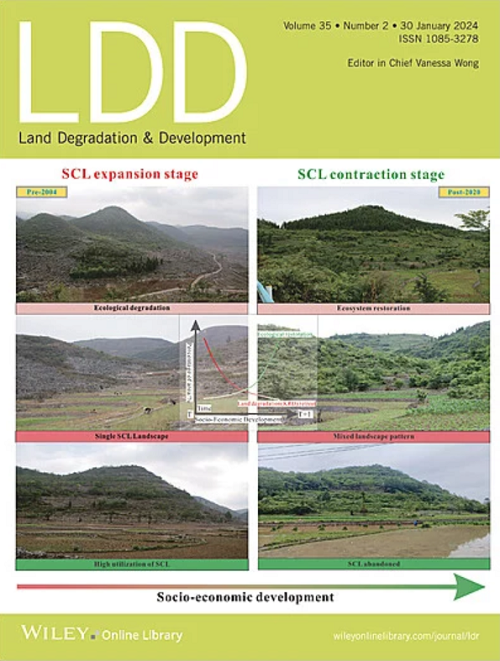Stoichiometry Influences on Microbial Necromass Carbon Contributions to Soil Organic Carbon in A Chinese Fir Plantation Under a 7‐Year Litter Manipulation
IF 3.6
2区 农林科学
Q2 ENVIRONMENTAL SCIENCES
引用次数: 0
Abstract
Microbial necromass is microbial assimilation metabolites that are important for soil organic carbon (SOC) accumulation. Stoichiometric ratios reflect the relative abundances of various elements in forest ecosystems, and the proportions of carbon (C), nitrogen (N), and phosphorus (P) in an organism affect its metabolic capacity, biomass, and final necromass yield. However, the mechanism by which soil stoichiometry regulates microbial necromass is unclear. The effect of soil stoichiometry on microbial necromass was investigated using a 7‐year field manipulation experiment in a subtropical Chinese fir (7年凋落物处理下杉木人工林微生物坏死体碳对土壤有机碳贡献的化学计量学影响
微生物坏死块是微生物同化代谢产物,对土壤有机碳积累具有重要意义。化学计量比反映了森林生态系统中各种元素的相对丰度,生物体内碳(C)、氮(N)和磷(P)的比例影响其代谢能力、生物量和最终坏死块产量。然而,土壤化学计量学调节微生物坏死的机制尚不清楚。以亚热带杉木(Cunninghamia lanceolata)人工林为研究对象,通过增加和去除地上凋落物,研究了土壤化学计量学对微生物坏死的影响。我们测量了微生物坏死物C对有机碳的贡献(MNC/SOC)、总养分和有效养分的化学计量比、微生物生物量和酶活性。凋落物添加显著提高0 ~ 10 cm土层的MNC/SOC,而凋落物去除显著提高MNC/SOC。有效养分的化学计量比(31%)和酶活性(15%)解释了MNC/SOC的变化。真菌的MNC/SOC与微生物生物量的C/N比和酶活性呈正相关,而细菌的MNC/SOC仅与速效养分的C/P和N/P比及酶活性呈正相关,说明真菌和细菌的MNC/SOC与化学计量比的关系并不完全相同。在20 cm土层以下,MNC/SOC与化学计量比的相关性不显著,表明二者随土层深度的增加而解耦。研究结果有助于全面理解亚热带森林土壤化学计量学,阐明亚热带森林土壤中碳含量的积累和贡献机制,为加强碳固存和改善土壤质量提供新的见解和研究方向。
本文章由计算机程序翻译,如有差异,请以英文原文为准。
求助全文
约1分钟内获得全文
求助全文
来源期刊

Land Degradation & Development
农林科学-环境科学
CiteScore
7.70
自引率
8.50%
发文量
379
审稿时长
5.5 months
期刊介绍:
Land Degradation & Development is an international journal which seeks to promote rational study of the recognition, monitoring, control and rehabilitation of degradation in terrestrial environments. The journal focuses on:
- what land degradation is;
- what causes land degradation;
- the impacts of land degradation
- the scale of land degradation;
- the history, current status or future trends of land degradation;
- avoidance, mitigation and control of land degradation;
- remedial actions to rehabilitate or restore degraded land;
- sustainable land management.
 求助内容:
求助内容: 应助结果提醒方式:
应助结果提醒方式:


